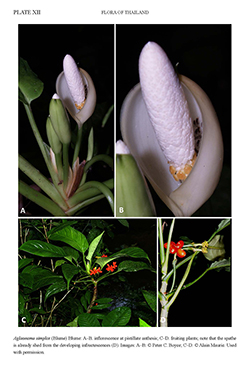e-Flora of Thailand
Volume 11 > Part 2 > Year 2012 > Page 117 > Araceae > Aglaonema
9. Aglaonema simplex (Blume) Blume
Rumphia 1: 152. 1837; Schott, Syn. Aroid.: 122. 1856 & Prodr. Syst. Aroid.: 305. 1860; Engl. in A.DC. & C.DC., Monogr. Phan. 2: 439. 1879; Engl. in Engl., Pflanzenr. IV, 23Dc (Heft 64): 22–23. 1915; Gagnep. in Lecomte, Fl. Indo-Chine 6: 1125. 1942; Hu, Dansk Bot. Ark. 23: 424. 1968; Nicolson, Smithsonian Contr. Bot. 1: 40–46. 1969; Li & Boyce in H.Li. Et al., Fl. China 23: 23. 2010.— Caladium simplex Blume, Catalogus: 103. 1823. Plate XII.
Accepted Name : This is currently accepted.
Synonyms & Citations :
Description : Medium, slender to somewhat robust, sub-pachycaul to suffruticose or decumbent, evergreen herbs. Stem erect, 15–120 cm tall, 0.4–1.7(–2.5) cm thick. Leaves several to rather many together, often clustered towards the shoot tips in larger plants; petioles 4.3–21.5 cm long; petiolar sheath with a membranous margin; leaf blade narrowly oblong, narrowly elliptic to lanceolate, occasionally linear, elliptic or ovate, 10–35 by 1.9–25 cm, base often unequal or oblique, obtuse, rounded or subtruncate, rarely acute or subcordate; apex often apiculate, acuminate, sometimes abruptly or gradually acuminate; primary lateral veins strongly differentiated, 3–14 per side; interprimary veins much less prominent, blade plain green, never variegated but the shade of green varying markedly between populations, thinly leathery. Inflorescences 1–6 together; peduncle 4–12 cm; spathe oblong-ovate, often apiculate, inflating at pistillate anthesis, then soon caducous at onset of staminate anthesis, 1.8–6.5 cm, decurrent for 3–15 mm, white; spadix cylindrical, equalling or slightly exceeding spathe, 1.7–4.3 cm, stipitate; stipe 2–12 mm; pistillate flower zone 3–10 mm long, with 12–38 flowers; staminate flower zone 1.5–3.8 by 0.5 cm, white, separated from the pistillate zone by a brief naked interstice. Fruits ovoid-ellipsoid, 1–1.7 by 0.8 cm, green, ripening through yellow to bright red.
Thailand : NORTHERN: Chiang Mai, Nan, Lampang; NORTH-EASTERN: Loei, Sakon Nakhon; EASTERN: Nakhon Ratchasima, Si Sa Ket; SOUTH-WESTERN: Kanchanaburi, Prachuap Khiri Khan; CENTRAL: Suphan Buri, Sara Buri, Nakhon Nayok; SOUTH-EASTERN: Sa Kaeo, Chon Buri, Rayong, Chanthaburi, Trat; PENINSULAR: Chumphon, Ranong, Surat Thani, Phangnga, Krabi, Nakhon Si Thammarat, Trang, Songkhla, Pattani, Narathiwat.
Distribution : India (Nicobar Islands) to W Maluku, SW China to Java.
Ecology : Evergreen forests, secondary forests, peat swamp forests, beach forests, occasionally on limestone or granite. 0–700 m alt.
Vernacular : Wan ngot hin (ว่านงดหิน)(Trang); wan khan mak (ว่านขันหมาก)(Central); phrom tin sung (พรหมตีนสูง)(Chanthaburi); hora (โหรา)(Trat).
Notes: Formerly the northern Thai populations of Aglaonema simplex were treated as a separate species, A. tenuipes, based solely on the larger inflorescence size. This is not here upheld. For details of the considerable typifications involved, see Nicolson 1969.

